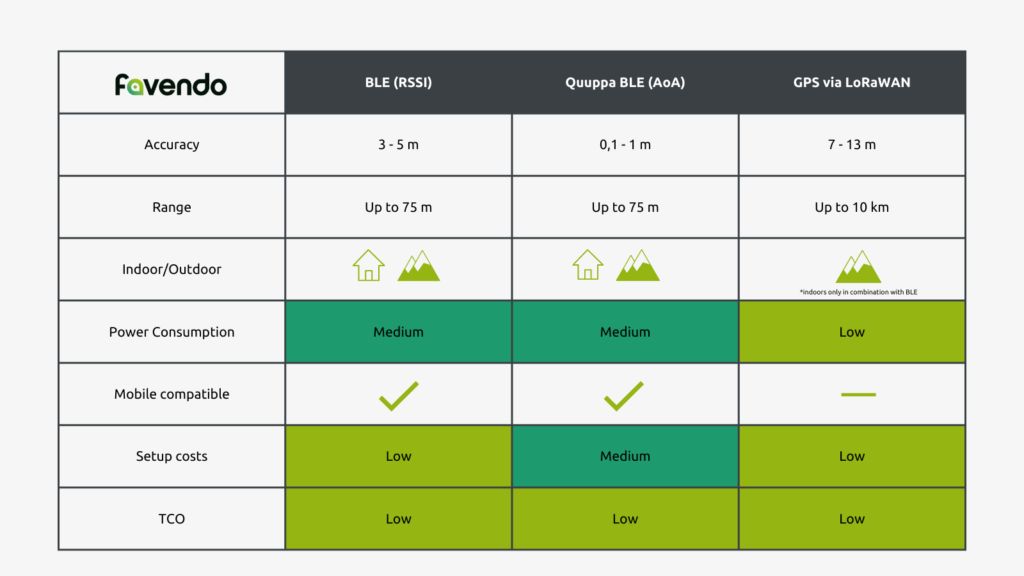19.08.2022
Technology compared: Which positioning technology fits your use case?

There are countless use cases for location or tracking solutions – both indoor and outdoor. Finding the right technology for the respective use case is a very complex task: What are the wishes and current requirements for the technology, and which could arise in the future? Once these points have been clarified, the next step is to compare technologies.
First of all, it is often a mistake to confuse technology and methodology, or to lump the terms together. For example, Bluetooth, WiFi or GPS are (radio) technologies used for positioning, while RSSI or AoA are the methods used to determine a location.
Just like use cases, there are also countless location technologies that work with specific methods. To go into all of them in depth would definitely go beyond the scope of this article and would require an enormous breadth of expert knowledge that Favendo alone cannot cover. Of course, we have tested various solutions over the past 10 years and learned from our customers’ experiences, but we still don’t know everything 😊. Therefore, in this article we limit ourselves to the technologies and methods that Favendo uses for RTLS solutions. Of course, this implies that this comparison is neither complete nor completely neutral. Nevertheless, we hope that the overview will help a little in the decision-making process or inspire you to discuss internally – or, of course, directly with us.
BLE (RSSI)
Bluetooth Low Energy with the RSSI (Received Signal Strength Indicator) method is the hobbyhorse of Favendo’s positioning and navigation solutions. BLE RSSI works with beaconing, which means that the mobile beacons transmit Bluetooth signals and corresponding fixed trackers measure the received signal strength to locate the tagged object.
In this way, an accuracy of 3-5 m can be achieved with indoor positioning and precise planning of the infrastructure. We also call this room-accurate positioning. With BLE RSSI, both tracking and navigation solutions can be implemented in real time. The big advantage is that the infrastructure costs and TCO of a BLE RSSI solution are very low.
BLE (AoA)
Like BLE RSSI, BLE Angle of Arrival is based on Bluetooth Low Energy as a positioning technology but works with a different method for determining position. Namely, with the calculation of the angle of arrival of the signal. This makes positioning extremely precise. The latency with BLE AoA is so low that even an ice hockey puck in a game can be tracked with it.
For the implementation of BLE AoA solutions, Favendo works together with Quuppa. The Quuppa locators use proprietary angle estimation algorithms and advanced signal processing in their tracking module to achieve extremely accurate positioning of less than 1m. Infrastructure setup costs are slightly higher when using Quuppa locators due to the more complex planning and installation process, but still remain far below the cost of a UWB system, for example.
GPS via LoRa or LoRaWAN
When using the term LoRaWAN, strictly speaking, the entire network structure between sensors, gateway and server is meant. LoRa, on the other hand, describes the radio technology with its unique range strength for data transmission. GPS is probably the best-known positioning technology, which everyone knows from their car navigation system. GPS (Global Positioning System) describes a global satellite navigation system.
In combination with LoRa sensors and a LoRa network, objects or people can be located with an accuracy of about 10 m over a range of up to 10 km in open terrain. The advantage of this technology combination is that LoRa sensors, for example from Abeeway, can also use BLE or WLAN in addition to GPS and thus enable seamless indoor/outdoor positioning
That was a lot of input? Stefan Balduf, CEO Favendo, sums it up a bit more compactly in this video. What we do, in which industries we have a lot of expertise and how you can benefit from Favendo as a solution provider. Short and concise in less than 3 minutes!
